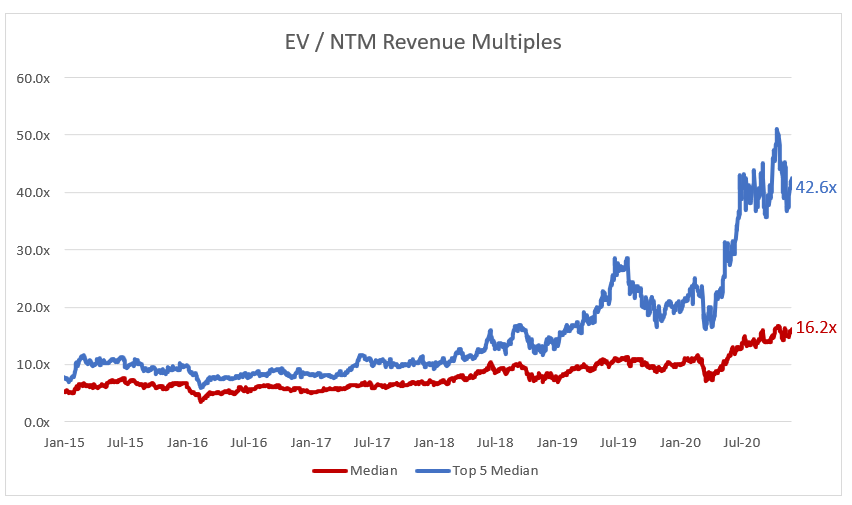Every week I’ll provide updates on the latest trends in SaaS valuations, earnings announcements, and highlight any significant news. Follow along to stay up to date!
Highlight of the Week - Upcoming Earnings
The next two weeks will wrap up cloud earnings season for 2020. A couple big weeks on deck! The below schedule shows when each company reports earnings.
Top 10 EV / NTM Revenue Multiples
Top 10 Weekly Share Price Movement
Update on Multiples
SaaS businesses are valued on a multiple of their revenue - in most cases the projected revenue for the next 12 months. Multiples shown below are calculated by taking the Enterprise Value (market cap + debt - cash) / NTM revenue. In the buckets below I consider high growth >30% projected NTM growth, mid growth 15%-30% and low growth <15%
Overall Stats:
Overall Median: 16.2x
Top 5 Median: 42.6x
3 Month Trailing Average: 15.1x
1 Year Trailing Average: 12.0x
Bucketed by Growth:
High Growth Median: 21.0x
Mid Growth Median: 13.8x
Low Growth Median: 7.1x
Operating Metrics
Median NTM growth rate: 21%
Median LTM growth rate: 31%
Median Gross Margin: 74%
Median Operating Margin (16%)
Median FCF Margin: 5%
Median Net Retention: 116%
Median CAC Payback: 25 months
Median S&M % Revenue: 45%
Median R&D % Revenue: 25%
Median G&A % Revenue: 18%
News
Salesforce is rumored to be acquiring Slack
Shopify announced Handshake, their new wholesale marketplace. It will allow merchants to transact directly with suppliers
JFrog announced an early lock-up release. Before this early lock-up release all shares held pre-IPO could not be traded until mid March. Now, up to 25% of locked-up shares can be traded starting on 12/14
Bill.com announced a $1B convertible note with a 0% coupon
Comps Output
Rule of 40 shows LTM growth rate + LTM FCF Margin. FCF calculated as Cash Flow from Operations - Capital Expenditures
GM Adjusted Payback is calculated as: (Previous Q S&M) / (Net New ARR in Q x Gross Margin) x 12 . It shows the number of months it takes for a SaaS business to payback their fully burdened CAC on a gross profit basis. Most public companies don’t report net new ARR, so I’m taking an implied ARR metric (quarterly subscription revenue x 4). Net new ARR is simply the ARR of the current quarter, minus the ARR of the previous quarter. Companies that do not disclose subscription rev have been left out of the analysis and are listed as NA.












Thank you!
Jamin, a big fan of your articles. would you be kind enough the publish the data in excel format?